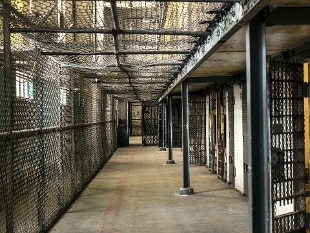- Prisons. Mayor: "San Gimignano structure abandoned to its fate"
- Prisons. Council of Europe rejects Italy: in the last places in Europe for overcrowding
Share
December 31, 2019 61,174 inmates for 50 thousand places. About 1,500 more than the end of 2018 and 3,500 more than 2017. These figures, provided by the Antigone association, which since 1991 has dealt with the penitentiary world since 1991, are enough to give the measure of how you live today in an Italian prison .The overcrowding rate is high
An overcrowding on which not only foreigners weigh, who, both in absolute and percentage terms, have decreased compared to last year. If at December 31 2018 there were 20,255, equal to 33.9% of the total inmates, at November 30 2019 they were 20,091, equal to 32.8% of the total. The official crowding rate is 121.2% of the capacity, however about 4,000 of the 50 thousand official places are not currently available and this leads to a 131.4% rate.
San Vittore, the prisoners are more than double the capacity
An example is that concerning the Milanese prison of San Vittore, where 246 places are not available and where the effective crowding rate is 212.5%, that is, there are more than two prisoners where there should be only one. Elsewhere things are no better, as in Como and Taranto, where the crowding rate is 202%. In general, at the moment, the most crowded region is Puglia, with a rate of 159.2%, followed by Molise with 161.4% and Friuli Venezia Giulia with 154.7%.
The president of Antigone: decreasing crimes, increasing inmates
"Once again we must see how, in the face of a decrease in crimes, the number of prisoners increases" declares Patrizio Gonnella, president of Antigone, an association that since 1991 has been dealing with rights and guarantees in the penal and penitentiary system. "This figure can be explained by an increase in penalties, the result of policies which, looking at a populistic use of criminal justice, responded in this way to a perception of insecurity that is not reflected in the number of crimes committed. That of the growth of prisoners it is a trend that in a short time could bring us back to the levels that cost Italy the sentence of the European Court of Human Rights for inhuman and degrading treatments ".
Visits to prisons
During 2019 Antigone, thanks to the authorizations it has received from the Department of Prison Administration since 1998, has visited 106 penitentiary institutions which are more than half of those present in Italy.
Life in the cell
The processing of the collected data is still in progress but the data emerging from the 66 files already worked return a worrying panorama for life in the institutes. First of all, in 27.3% of the institutes visited, more than a quarter, there would seem to be cells in which prisoners have less than 3 square meters per head of floor space available, a condition that the Italian Cassation considers inhuman and degrading, in violation art. 3 of the European Convention on Human Rights.
Furthermore, in more than half of the institutes, cells without hot water were found and, in another five, cells in which the toilet is not in a room separate from the rest of the room.
The health situation
Concern also emerges about the health situation in prisons. In one third of the institutions visited, there was no 24-hour doctor and on average for every 100 prisoners there were less than 7 hours of psychiatric service and about 11 hours of psychological support available. A very low presence if we consider the psychiatric pathologies from which part of the prison population suffers. In fact, the observations of the Antigone observatory showed that 27.5% of the over 60 thousand prisoners were taking psychiatric therapy. In addition, 10.4% were drug addicts with ongoing replacement drug treatment.
Little work
Also as regards work, the situation has not improved compared to past years. Inmates who worked for the prison administration are, on average, around 25% and, in most cases, this commitment is only a few hours a day. Only 2.2% work for a private cooperative or for an external employer. Finally, in 30% of the institutions visited, there is no professional training course.
Little staff
A shortage of prison staff also emerges from the Antigone picture, the majority of which are police officers. On average, there is an agent for fewer than 2 inmates and an educator for every 94 inmates. Furthermore, only a little more than half of the institutes had a full-time director. “Speaking of new hires in prisons - Patrizio Gonnella concludes - we hope that young directors will unlock soon. The call has been stopped for too long. This affects the re-educational purpose of the penalty provided for in article 27 of the Constitution ".

